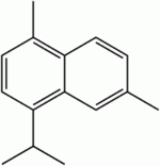
Cadalene
Encyclopedia
Cadalene is a polycyclic aromatic hydrocarbon
with a chemical formula C15H18 and a cadinane skeleton. It is derived from generic sesquiterpene
s, and ubiquitous in essential oil
s of many higher plants.
Cadalene, together with retene
, simonellite
and ip-iHMN, is a biomarker of higher plants, which makes it useful for paleobotanic analysis of rock sediment
s.
The ratio of retene to cadalene in sediments can reveal the ratio of the genus Pinaceae
in the biosphere.
Polycyclic aromatic hydrocarbon
Polycyclic aromatic hydrocarbons , also known as poly-aromatic hydrocarbons or polynuclear aromatic hydrocarbons, are potent atmospheric pollutants that consist of fused aromatic rings and do not contain heteroatoms or carry substituents. Naphthalene is the simplest example of a PAH...
with a chemical formula C15H18 and a cadinane skeleton. It is derived from generic sesquiterpene
Sesquiterpene
Sesquiterpenes are a class of terpenes that consist of three isoprene units and have the molecular formula C15H24. Like monoterpenes, sesquiterpenes may be acyclic or contain rings, including many unique combinations...
s, and ubiquitous in essential oil
Essential oil
An essential oil is a concentrated hydrophobic liquid containing volatile aroma compounds from plants. Essential oils are also known as volatile oils, ethereal oils or aetherolea, or simply as the "oil of" the plant from which they were extracted, such as oil of clove...
s of many higher plants.
Cadalene, together with retene
Retene
Retene, methyl isopropyl phenanthrene or 1-methyl-7-isopropyl phenanthrene, C18H18, is a polycyclic aromatic hydrocarbon present in the coal tar fraction, boiling above 360 °C. It occurs naturally in the tars obtained by the distillation of resinous woods. It crystallizes in large plates, which...
, simonellite
Simonellite
Simonellite is a polycyclic aromatic hydrocarbon with a chemical formula C19H24. It is similar to retene....
and ip-iHMN, is a biomarker of higher plants, which makes it useful for paleobotanic analysis of rock sediment
Sediment
Sediment is naturally occurring material that is broken down by processes of weathering and erosion, and is subsequently transported by the action of fluids such as wind, water, or ice, and/or by the force of gravity acting on the particle itself....
s.
The ratio of retene to cadalene in sediments can reveal the ratio of the genus Pinaceae
Pinaceae
Pinaceae are trees or shrubs, including many of the well-known conifers of commercial importance such as cedars, firs, hemlocks, larches, pines and spruces. The family is included in the order Pinales, formerly known as Coniferales. Pinaceae are supported as monophyletic by its protein-type sieve...
in the biosphere.

